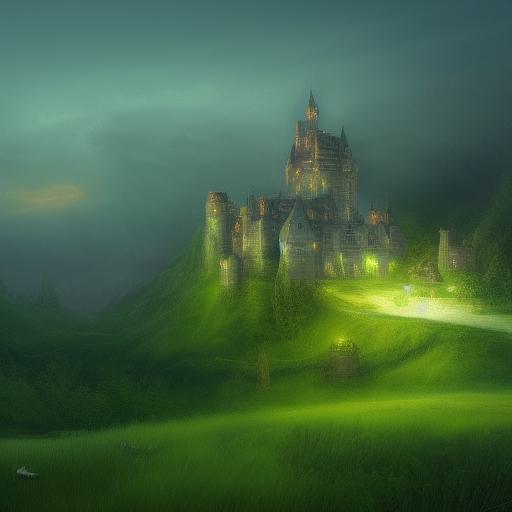How to write this prompt?
Here’s a breakdown of each component of the prompt and how it influences the image being generated:
- Genre: “Fantasy”
- This sets the overall genre or theme of the image being generated. In this case, it’s fantasy, which suggests a magical or otherworldly setting.
- Setting: “Summer landscape art”
- This specifies the type of landscape being depicted. In this case, it’s a summertime landscape, which can evoke feelings of warmth and relaxation.
- Mood: “Serene”
- This sets the mood or atmosphere of the image. In this case, it’s serene, which suggests a peaceful and calming scene.
- Style: “Hyperrealism“
- This specifies the style in which the image is being created. Hyperrealism aims to make the image look as realistic as possible, often using techniques like high detail and vivid colors.
- Subject: “A castle sitting on top of a lush green hillside”
- This is the main subject of the image, and what the AI will be generating. In this case, it’s a castle situated on a hillside, surrounded by greenery.
- Time of Day: “At night time”
- This sets the time of day for the scene being depicted. In this case, it’s nighttime, which can create a sense of mystery and intrigue.
- Reference: “A digital painting by Jakub Husnik, trending on polycount”
- This provides a reference for the type of image being generated, and can give the AI a starting point for the style and composition of the image.
- Additional details: “Fantasy art, nighttime nature landscape, night scenery, background art”
- These additional details can help to further refine the image being generated, such as specifying that it’s a nighttime nature landscape or that the castle is part of the background art.
What is hyperrealism in art?
Hyperrealism is a style of art that aims to create highly realistic and detailed images that look almost like photographs. It often involves the use of high-resolution images and meticulous attention to detail to create a sense of heightened reality.
How to create a fantasy landscape painting?
To create a fantasy landscape painting, you’ll need to start by sketching out your ideas and planning out the composition of your image. You can then use various painting techniques and tools to create a detailed and vivid scene, such as using glazes to build up layers of color and texture, or using a variety of brush strokes to create different types of foliage and terrain.
Why is nighttime a popular theme in fantasy art?
Nighttime is a popular theme in fantasy art because it can create a sense of mystery and intrigue. It can also allow for the use of more dramatic lighting and shadow effects, which can help to highlight certain aspects of the scene or create a certain mood or atmosphere. Additionally, nighttime can be a popular choice for fantasy art because it allows for the depiction of fantastical creatures and beings that may only come out at night.
How does AI generate art?
AI can generate art using a variety of techniques and algorithms. One common method is to use a type of neural network called a Generative Adversarial Network (GAN), which consists of two parts: a generator and a discriminator. The generator creates new images based on a set of inputs or training data, while the discriminator evaluates the generated images and provides feedback to the generator. Through repeated training and refinement, the generator is able to create increasingly complex and realistic images.
Another method for AI-generated art is through the use of Style Transfer algorithms, which involve taking an existing image and applying the style or characteristics of another image onto it. This can be used to create new and interesting variations on existing artwork, or to combine different artistic styles in new and innovative ways.
Other techniques for AI-generated art include using genetic algorithms, deep learning, and computer vision to create and manipulate images in various ways.
What types of art can be generated using AI?
AI can be used to generate a wide variety of art, from traditional styles like painting and sculpture to more modern forms like digital and interactive art. Some examples of AI-generated art include:
- Digital paintings and illustrations, which can be created using GANs or other machine learning algorithms. These can range from simple sketches to highly detailed and realistic images.
- 3D printed sculptures, which can be generated using algorithms that create complex and intricate shapes and patterns.
- Music and soundscapes, which can be generated using neural networks and machine learning algorithms that analyze existing music and create new compositions based on the patterns they detect.
- Interactive installations and performances, which can use AI to respond to user input and create unique and immersive experiences.
Overall, AI-generated art has the potential to push the boundaries of what is possible in the world of art and creativity, and can provide artists with new tools and techniques to explore and experiment with.
Visualize your ideas like never before with the power of AI-generated art and design tools from Visual Paradigm Online. Elevate your designs to the next level by effortlessly integrating stunning graphics with just a few clicks. With a user-friendly interface and a vast selection of design templates and assets at your disposal, you can explore and experiment with various styles and layouts until you create the perfect masterpiece. Discover the limitless potential of AI-generated art and transform your creative vision into reality with Visual Paradigm Online.


